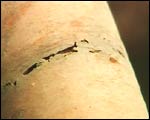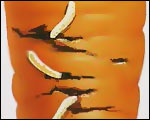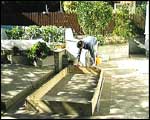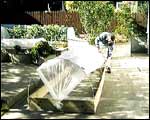Keeping carrot fly and other nasties at bay
The carrot fly poses
a serious threat to carrots and can damage up to 90% of the roots.
It's that time of year again when seeds are sown and seedlings are transplanted out into the veggie garden. It's also that time of year when the nasties appear, and Prof Walker, our perennially cheerful vegetable oracle, is troubled by what's pursuing his carrots.
The carrot fly starts off in October, or a little earlier in the North Island. It lays its eggs near the carrot. These eggs hatch into small, white larvae, like a little white worm, and these make their way down into the carrot. They attack the fine roots first, then the carrot itself.
Incidences of carrot rust fly, as they're also known, were recorded in England in 1814. In NZ the fly was first found and recorded in Auckland in 1931. By 1952 it was as far south as Palmerston North. By 1980 it had officially spread to the South Island, though growers had been aware of it as early as 1960. The carrot fly poses a serious threat to carrots and can damage up to 90% of the roots.
Another excellent method is to use a special cover to enclose the whole crop to keep out the fly. Prof Walker says he knows people who have had great success using a microclimate cloth to grow their carrots.
At this time of the year it can also be used to aid germination of small seeds and to keep the wind off plants. It can also be used as a protection from heavy rain and animals, such as cats. The material used for the cover is a porous, knitted cloth. It not only lets air and water through, it also keeps out the bugs, such as the carrot fly and other insects. For anybody wanting to keep carrot fly at bay without using chemicals, this is ideal. Other Methods to Reduce Carrot Fly To minimise the damage from carrot fly:
|
Home | Journal
| Newsletter | Conferences
Awards | Join
RNZIH | RNZIH Directory | Links
© 2000–2024 Royal New Zealand Institute of Horticulture
Last updated: September 24, 2004



 You
can see here the damage caused by carrot fly. It's not severe, but
obviously it wouldn't look good in a shop. If the carrot fly attacks
the carrot when it's younger, however, it will kill the carrot.
You
can see here the damage caused by carrot fly. It's not severe, but
obviously it wouldn't look good in a shop. If the carrot fly attacks
the carrot when it's younger, however, it will kill the carrot.
 Those
larvae eventually pupate and turn into another fly. The whole process
takes about eight to 12 weeks. You then get more flies hatching
and the whole process starts all over again. You can get three or
four generations in one year, the last one about May.
Those
larvae eventually pupate and turn into another fly. The whole process
takes about eight to 12 weeks. You then get more flies hatching
and the whole process starts all over again. You can get three or
four generations in one year, the last one about May.  One
of the methods Prof Walker found most effective is to use pelleted
carrot seed (supplied by his commercial friends) which have been
pelleted with an insecticide. However, this method is presently
unavailable to the home gardener.
One
of the methods Prof Walker found most effective is to use pelleted
carrot seed (supplied by his commercial friends) which have been
pelleted with an insecticide. However, this method is presently
unavailable to the home gardener.  Not
only is it effective against carrot fly, it can be used for all
kinds of purposes. Prof Walker leaves it on most of the time for
his strawberries, but for other crops he tends to take it off when
the plants are coming into maturity. For the carrots, however, he
leaves it on all the time.
Not
only is it effective against carrot fly, it can be used for all
kinds of purposes. Prof Walker leaves it on most of the time for
his strawberries, but for other crops he tends to take it off when
the plants are coming into maturity. For the carrots, however, he
leaves it on all the time. 